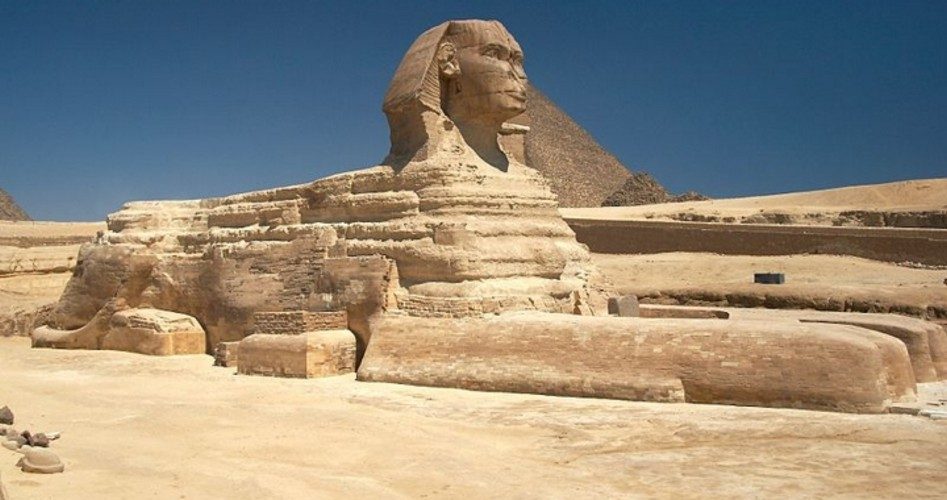
Murgan Salem al-Gohary, an Egyptian jihadist, has called for the destruction of the Sphinx and the great pyramids so long associated with the splendor of Ancient Egypt. In a November 10 interview on an Egyptian television station, al-Gohary denounced those historical monuments as idols offensive to Islam: “All Muslims are charged with applying the teachings of Islam to remove such idols, as we did in Afghanistan when we destroyed the Buddha statues. God ordered Prophet Mohammed to destroy idols. When I was with the Taliban we destroyed the statue of Buddha, something the government failed to do.”
Other Muslims disagree. Sheikh Abdel Fattah Moro, the vice president of Tunisia’s Ennahda Party, agrees that when Amr ibn al-Aas conquered Egypt for Islam, he did not seek to destroy the Sphinx and other ancient monuments, and Moro gave the reason: “The Prophet destroyed the idols because people worshiped them, but the Sphinx and the Pyramids are not worshiped.”
Most Egyptians have regarded these ancient monuments as an integral part of Egyptian culture. Ahmed Osman, an Egyptian author who is an expert on ancient Egypt, told Al-Arabiya English, “The fundamental Salafis have demanded to cover Pharaonic statues, because they regard them to be idols. But so far the government has done nothing to indicate what is the future of Egyptian antiquities.” The nation has been dominated by Muslim governments for 1,400 years, and during those centuries Egyptians sought to preserve, not destroy, relics which were an important party of ancient history.
What al-Gohary is proposing in Egypt is what radical Muslims in other parts of the world are doing to ancient monuments and relics of different faiths. In late October, 19 Buddhist temples were vandalized by Muslim mobs. The Bangladeshi government is paying for the restoration of those temples, however, and Ruhul Amin of the government said: “The army has already started work. We have sat with Buddhist community leaders to finalize the designs. The temples will be rebuilt almost to their old shape.”
The Taliban had destroyed Bamiyan, the world’s tallest standing Buddha, measuring 50 meters, in March 2001, despite an outcry from the rest of the world. Taliban Minister of Information and Culture Qudratullah Jamal said at the time that this act was intended to keep people from worshipping false idols. He added, “It will be destroyed by every means. All the statues are being destroyed.”
Islam had ruled Afghanistan since the 7th century, and at no time had any of the Muslims who ruled that nation attempted to destroy these ancient Buddhist statutes, which were already more than 1,000 years old when Muslims conquered Afghanistan. What was true in Afghanistan was also true in other parts of the world conquered by Muslims.
India, for example, was home to Hindus, Jains, and Sikhs, as well as Buddhists. The Golden Temple of the Sikhs at Amritsar is considered a masterpiece of architecture. The Mogul rulers of India, though Muslim, did not destroy this holy shrine of another faith. The Bodhi tree, which is the site in which the Buddha is thought to have meditated before he developed his religion, was left alone by the Moguls. India is full of magnificent religious temples and shrines which reflect the myriad metaphysical systems of that complex land.
The Ottoman Turks conquered Constantinople in 1453, and the Church of Saint Sophia or Haggia Sophia, was constructed by the Byzantines in 360. The Ottoman conquerors of Constantinople not only did not destroy this most important Orthodox church, but they converted it into a mosque (and modern Turkey has turned it into a museum).
Muslim invaders have historically destroyed manuscripts as part of their conquests, and the library at Alexandria, which may have contained close to one million scrolls dating back to before Roman times, was lost to mankind in 642. Muslim conquerors also destroyed the Library at Ctesiphon in 651 by throwing its many thousands of ancient texts into the Euphrates River, depriving the world of much knowledge of the Parthian and Sassanian empires as well as the religious texts of the Zoroastrian faith.
But the destruction of works of art, architectural masterpieces, and places of worship of other faiths is pushing the envelope of Islamic intolerance to a level which even the first followers of Mohammed never embraced. What is lost if the Sphinx is destroyed can never be replaced. What happens in Egypt will tell a lot about how the rest of the world will be able to interact with modern Islam.
Photo of Sphinx and Great Pyramid of Egypt



